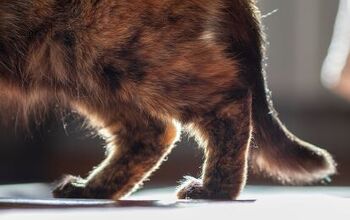Goldmaraner


About Goldmaraner
Once socialized, the loyal and playful Goldmaraner makes a great family dog that brings together the often aloof, independent personality of the Weimaraner and the friendly, gentle nature of the Golden Retriever. This large, intelligent dog is highly active and needs an owner who can devote the amount of time necessary to ensure his physical needs are met and that he receives continual mental stimulation to prevent him from becoming bored and stressed. When left on his own for long periods, he can become restless, agitated and highly destructive so is ideally suited to a home where a family member works out of the house or it can be organized that a dog walker visits during the day to get him out, exercised and ultimately feeling more relaxed. Because the Weimaraner side of this dog brings a strong prey drive it’s important that your Goldmaraner has been properly socialized before introducing him to kids, pets and other animals. His alert, devoted nature means he will always be quick to bark when he feels it necessary and therefore makes a great watchdog and super companion animal when out for walks, hikes or jogs.
The loyal Goldmaraner is a playful combination of the often aloof Weimaraner and the always sweet-natured Golden Retriever.
The Goldmaraner’s Designer Dog status places him around the 1980s, when breeders first began crossing two or more popular pure-breds to produce a dog that was healthier, often non-shedding and sometimes smaller and gentler than many of the foundation breeds. With the Goldmaraner, his pure-bred parents include the Golden Retriever and the Weimaraner and while his brief, 30-year history positions him as being a relatively new breed, his parents date back more than a century. The Weimaraner (also known as the Grey Ghost because of his silver coat) originated in 1800’s Germany where he was specifically bred for the strength, speed and agility needed in a great hunting dog. With the Golden Retriever you have a dog that was developed in Scotland back in the mid-19th century to fill the need for a hunting dog that was adept on land and in water and could bring back waterfowl with a gentle “mouth” meaning without damaging the bird.
Because the American Kennel Club (AKC) is devoted to advocating for pure-bred dogs, the cross-bred Goldmaraner will never qualify for membership however both of his parent breeds are members in good standing. The iconic Golden Retriever has been a member of AKC’s “sporting” group since 1925 and is described as being friendly, intelligent and devoted. The somewhat aloof Weimaraner joined their “sporting” group back in 1943 and is described as being a friendly, fearless and obedient dog.
The high energy Goldmaraner needs to be fed a diet comprised of a high-quality dry food that has been specifically designed to meet his age, activity level and the nutritional needs of a large dog. Because this dog can experience bloat, it’s important that he not be allowed to free-feed but be fed 2 to 3 smaller meals throughout the day and that exercise not be planned for within an hour of him eating. Because this dog can experience joint issues later in life, you will need to establish and maintain an ideal weight by selecting foods and treats that are high in protein and low in fillers that can result in him constantly hungry and looking to supplement his meals – including raiding the cat’s dish. Similarly treats should be healthy, top quality and dispensed only as earned or warranted.
The Goldmaraner is a loyal, devoted family dog that can be highly protective which makes him a great watchdog.
Although your Goldmaraner is the offspring of two super intelligent breeds who are quick to pick up and obey commands, the Weimaraner side brings a little attitude to the mix and his aloof, headstrong personality may crop up during the training process. As a result, you will need to take a firm, consistent approach to reinforce pack leadership, but also apply plenty of patience and use rewards to encourage engagement and cooperation with this dog. Remember that a stubborn, disobedient pup can grown into a big dog with a similar attitude, so start his training while he is still young – around the 2-month mark – when he is still willing to listen and learn. Socialization is extremely important with this pup as the predatory Weimaraner in him can make this dog persona non grata at off-leash parks. Exposure to new faces, sights, smells and situations will help build confidence and discourage aggressive behaviors. Because Goldens are known to love loads of praise, you should find training opportunities where he can showcase his ability to respond to commands. If you have lots of treats on the ready, you’ll be best buddies for life.
Once he has reached adulthood, your Goldmaraner will weigh somewhere between 50 to 65 pounds. This weight will vary depending on your dog’s gender as well as how heavily the DNA from each side of his parent breeds influences his make up.
The Goldmaraner is a loyal, devoted family dog that can be highly protective which makes him a great watchdog. The importance of early socialization cannot be stressed enough with this pooch because his Weimaraner genes can make for a dog with a potentially high prey drive and a tendency to chase smaller animals and become aggressive towards other dogs. Exposing him to new faces, sights, sounds, and different experiences while he is still young will help him learn to cope with new situations and ensure he successfully assimilates himself with others. Once socialized, the Goldmaraner is a playful, loving family pet that does well with kids of all ages, is super-active and ready to become involved in all family activities. Because he is so active, this pooch can become bored and extremely destructive if his need for exercise and mental stimulation isn’t met and this can result in chewing, digging and incessant barking. He needs an owner or family that can devote the time necessary to ensure he is kept busy and active and that he isn’t left on his own for long periods of time – either indoors or outdoors.
Your Designer Dog will typically be healthier than either of his pure-bred parents however you should always understand what ailments your new pup could inherit down the line. With the Goldmaraner, this can include certain cancers from the Golden Retriever as well as joint issues such as hip dysplasia from both breeds. The Weimaraner brings the potential for bloat and a congenital heart condition known as tricuspid valve dysplasia. While this list of potential health issues may sound overwhelming, don’t be put off. It’s quite possible that your Goldmaraner may never experience any of these ailments over the course of his life.
The Goldmaraner is a large, active dog and with regular exercise, a diet designed for his age, size and energy level as well as annual check-ups with your vet to monitor his health, he will live a long healthy life of between 10 and 12 years.
Your Goldmaraner comes from two highly active breeds so you can expect him to be a dog that not only loves exercise but needs it in order to remain physically fit and mentally stimulated. Long walks in the 1-hour range should always be part of his daily regimen, but this dog will also enjoy interactive games where he can run, play and show off his agility talents when it comes to catching and retrieving tossed balls or frisbees. Remember that Goldens thrive on loads of praise and this pooch will always appreciate the opportunity to display his fetching and retrieving abilities for some well-earned treats. Because the Weimaraner side of this dog means he may have a high prey drive, it’s important that prior to taking him to off-leash parks, you know that he has been properly socialized. Ideally this training will have happened when he was still young, however unless you know for certain that he will play nice, you may find that his inherent instinct to chase and potentially harm smaller dogs or squirrels may present.
The loyal and loving Goldmaraner can be aggressive toward other dogs and animals if not properly socialized.
The Goldmaraner is also known as the Goldmaraner Pointer and Goldemaraner Pointer and while this dog’s Designer breed status means he will never qualify to join the American Kennel Club’s roster of purebred dogs, he is recognized by several lesser known clubs including: Dog Registry of America, Inc. (DRA), American Canine Hybrid Club (ACHC) Designer Breed Registry (DBR), Designer Dogs Kennel Club (DDKC) and International Designer Canine Registry (IDCR).
Your Goldmaraner is the offspring of the heavy-shedding Golden Retriever and the low-shedding Weimaraner and while it would be great if he could inherit the long, soft coat of the Golden without all that excess hair flying around the house, sadly that isn’t likely to be the case. His coat texture could resemble that of either breed – hard and short or longer and flowing – but regardless of the outcome, he is considered a moderate shedder who will need brushing 2 to 3 times a week (and more frequently during shedding season) to keep him looking his best and particularly if his hair is longer, to prevent matts and tangles. Because he will undoubtedly have inherited the floppy ears common to both breeds, you should plan to do a quick visual inspection and clean with a damp cotton ball once a week. This simple step can help prevent a build up of wax, dirt and bacteria that may result in a smelly and uncomfortable yeast infection that is common in floppy-eared dogs. If your pooch takes after the Golden and loves to swim, make sure that afterwards, his inner ears are entirely dry to prevent moisture build-up and infection.
Because Goldmaraner pups can grow to become headstrong and potentially aggressive dogs – in a larger format that makes them even more difficult to control – it’s important that your little guy’s socialization begins at a very young age. This includes handling him as young as just a couple of week of age and with intentional, controlled exposure to new faces, sights and sounds to help build a comfort level and confidence that will help him ease into new situations without the need to act out. As he may inherit the high prey genes of the Weimaraner, obedience training should also begin while this pup is very young and willing to listen, learn and obey commands. If he does begin to chase or act aggressively toward other animals, the ability to have him stop, sit and respond immediately to your commands will be important. While the Goldmaraner pup is without doubt going to be highly active and keen to play, remember that this dog can suffer from joint issues later in life so take it easy with the exercise and playtime to ensure tiny limbs are never over-exerted and accidentally injured.
Photo credits: Rebell/Shutterstock; Andre Nery/Shutterstock; Robert Eastman/Shutterstock

Sharing space with three seriously judgy Schnoodles and a feline who prefers to be left alone. #LivingMyBestLife
More by Mary Simpson

























